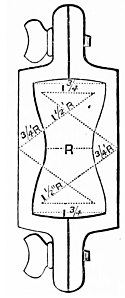amount of water to render it plastic. Too small an amount will leave some particles dry; too large an amount will gather in masses, will evaporate, leaving pores, and will give too small results. The test is now commonly made by molding a briquette  Fig. 1 of a form approved by engineers, as shown in Fig. 1, which is drawn of one third actual size. The mold is a clamp of metal exactly one inch in thickness and exactly one inch across at R. This makes the area of the smallest place exactly an inch. The moistened cement is carefully placed in the mold with a spatula and pressed enough to render the whole mass homogeneous. It is left in the mold until it can be removed by opening the mold, and then it is exposed to the air for exactly twenty-four hours, after which it is put into water and allowed to rest there until the test is made. The length of time depends upon the purpose of the test. In order to make certain that all the cement produced is of a uniform quality, seven days is sufficient. Such a test is made of every lot shipped by the Milwaukee Cement Company, and probably by all other reliable manufacturers. If the test is to determine the ultimate strength developed or to compare cements from different sources,
Fig. 1 of a form approved by engineers, as shown in Fig. 1, which is drawn of one third actual size. The mold is a clamp of metal exactly one inch in thickness and exactly one inch across at R. This makes the area of the smallest place exactly an inch. The moistened cement is carefully placed in the mold with a spatula and pressed enough to render the whole mass homogeneous. It is left in the mold until it can be removed by opening the mold, and then it is exposed to the air for exactly twenty-four hours, after which it is put into water and allowed to rest there until the test is made. The length of time depends upon the purpose of the test. In order to make certain that all the cement produced is of a uniform quality, seven days is sufficient. Such a test is made of every lot shipped by the Milwaukee Cement Company, and probably by all other reliable manufacturers. If the test is to determine the ultimate strength developed or to compare cements from different sources, Fig. 2. then a series of tests should be made by breaking "briquettes" made at the same time but left in water for different periods. The reason is, that a quick-setting cement 'will develop its full strength in a short time, and if the test is made at the end of that time it might show a greater tensile strength than another one slow in setting, even when the latter would ultimately have several times its strength.
Fig. 2. then a series of tests should be made by breaking "briquettes" made at the same time but left in water for different periods. The reason is, that a quick-setting cement 'will develop its full strength in a short time, and if the test is made at the end of that time it might show a greater tensile strength than another one slow in setting, even when the latter would ultimately have several times its strength.
The test can be made in any form of testing machine, though one in which the test is applied by uniformly increasing the strain, as by running shot into a bucket upon the end of a lever, gives the most accurate results; but the briquette should be held in a clutch that presses accurately upon the sides, as shown in Fig. 2. This applies the tension equally, and gives a very accurate test. A long series of these were made by Mr. D. J. Whettemore, C. E., at Milwaukee in 1874, in which seventeen native cements showed an average tensile strength at the end of seven days of 808/10 pounds. The lowest of these broke at 38 pounds, while the highest sustained 1392/3 pounds. Later tests made in

